Yoga Management of Diabetes includes yoga poses, pranayama along with other lifestyle changes. A healthy, balanced diet plan and proper medication is essential to keep diabetes under control. There is one more factor – one more cornerstone for effective diabetes management. And, that’s exercise. While all forms of cardiovascular exercises do help, studies suggest that yoga is the best as it improves the overall well-being. According to various scientific studies, regular practice of yoga could improve insulin sensitivity, lower the dose of anti-diabetic drugs, aid in weight loss, and prevent sugar levels from increasing. Moreover, yoga has the potential to curb stress, one of the prime culprits behind diabetes and its associated complications.
Read on to know more about the Asanas and Pranayama for yoga management of diabetes.
ASANAS FOR YOGA MANAGEMENT OF DIABETES
-
Padangusthasana – Hand to Big Toe Pose
The posture improves circulation to the brain to ease stress. Being a forward fold, it massages the abdominal organs, stimulating and detoxifying them.
Stand with the feet separated hip-distance apart. Inhale and lift the arms over the head. With the exhalation, fold forward from the hips, lengthening the spine, allowing the abdomen to rest on the thighs. Hold the big toe with the thumb, index, and middle fingers, thumb resting over the big toe. Inhale and gaze up and bring the spine parallel to the floor. On the next exhalation, complete the forward fold, allowing the forehead to rest closer to the shin.
Hold the posture, breathing deeply, for 5 to 7 deep breaths.
-
Parivrtta Prasarita Padottanasana – Revolved Wide-Legged Forward Bend
Twists are beneficial for the digestive organs as they promote detoxification. This posture also activates the pancreas, enabling better insulin sensitivity. Also, this posture being a forward fold is beneficial to relax the body and mind.
Stand with the legs separated about 4 feet apart, feet angling about 45 degrees away from the body. Engaging the core, inhale, and lengthen the torso. On an exhale, fold forward from the hips, pushing the hips backwards. Place the palms in between the legs on the floor.
Pressing the left palm into the floor, inhale and twist to the right, lifting the right hand to the ceiling. Exhale and inhale. On the next exhalation, deepen the twist to open the chest to the ceiling, stacking the shoulders. Gaze at the right fingertips.
Hold the posture for seven deep breaths. Inhale and release the posture. Repeat on the other side.
-
Paschimottanasana – Seated Forward Bend
The posture works like Padangusthasana and offers similar benefits.
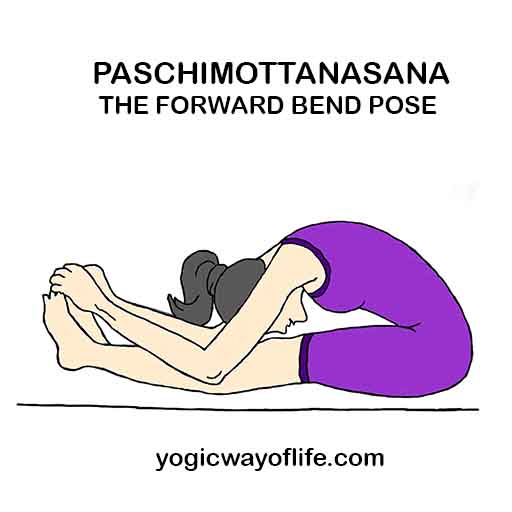
Sit in Dandasana, spine long and aligned with the neck and head. Inhale and lengthen the torso. While breathing out, hold the big toes and fold forward from the hips, allowing the abdomen to rest on the thighs as chest moves forward. Avoid rounding the upper back. One can hold the shin bone or bend the knee to prevent rounding or folding from the lower back.
Hold the posture for seven deep breaths. Inhale and release the toes and sit straight.
-
Gomukhasana – Cow Face Pose
This posture is a variation of the classic pose where the fingers are interlaced on your back. This posture includes a forward fold to offer a gentle massage to the internal organs, while working to ease stress.
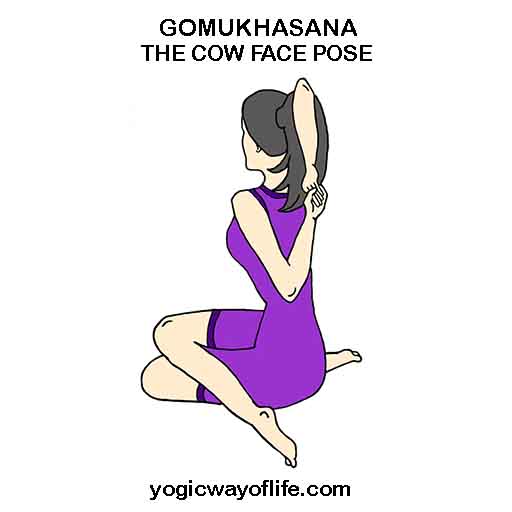
From Dandasana, bend the right knee and place the right heel close to the left sitting bone. Bend the left knee, cross it over the right, and place it close to the right sitting bone. Hold the foot with opposite hands. Inhale and straighten the torso. Breathe out and fold forward, pressing the abdomen on the thighs. If possible, rest the forehead on the floor.
Hold for seven deep breaths. Inhale and straighten the torso. Uncross the legs and release the tension. Repeat by crossing the right leg over the left.
-
Ardha Matsyendrasana – Seated Spinal Twist
The twist cuts off blood supply to the abdominal organs by compressing them. But, as the twist is released, the organs receive an increased blood supply that cleanses and energizes them. In simple terms, Ardha Matsyendrasana stimulates the optimal functioning of pancreas, ensuring better insulin sensitivity.
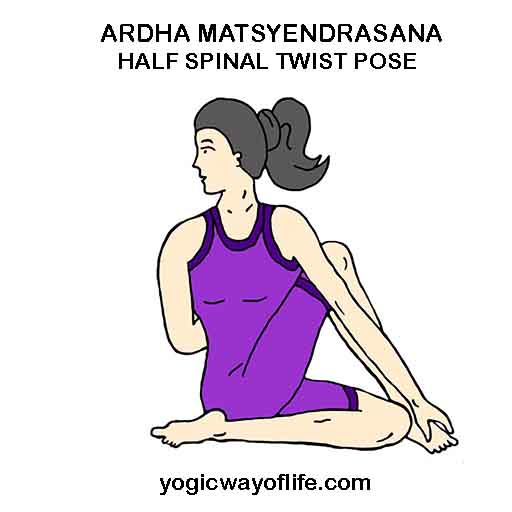
From Dandasana, bend the right knee and place the heel under the left hip bone. Bend the left knee and place the left foot outside the right knee. Place the left palm behind you on the floor. Inhale, lengthen the torso, and bring the right elbow outside the left knee and hold the left ankle. Inhale and while breathing out, twist to the left.
Lengthen the spine with each inhalation. With every exhalation, deepen the twist. Hold the posture for seven deep breaths. Inhale and come back to the center. Exhale and repeat on the other side.
-
Dhanurasana – Bow Pose
This posture is a back bend that has multiple benefits. It is good for the digestive system. It tones the back, legs, and belly fat. It eliminates toxins and promotes circulation.
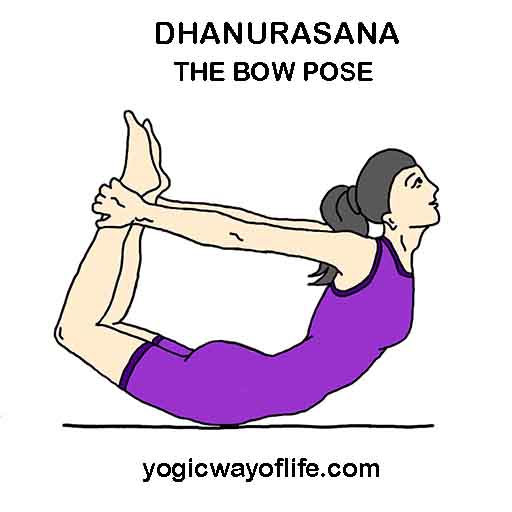
Lie down on the stomach legs stretched out backward. Bend the knees and hold the respective ankles. Inhale and lift the torso from the floor. Simultaneously, pull the legs up using the palms so that the knees and thighs are away from the floor. Engage the core and balance on the stomach.
Gaze forward or slightly tuck the chin to the chest to avoid any pressure on the neck. Hold the posture for seven deep breaths.
-
Jathara Parivartanasana – Reclining Spinal Twist
Relax the spine and release the tension from the entire body and mind with this reclining supine twist. Just like other twists, this posture is beneficial for stimulating detoxification and proper functioning of the pancreas.
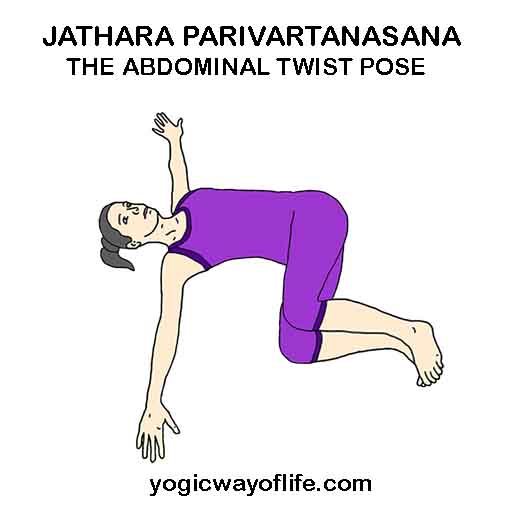
Lie down on the floor, back resting on the floor. Hug the knees to the chest with the inhalation. Stretch out the arms at shoulder level, palms resting on the floor. While breathing out, rest the knees to the right and twist the torso to the left. Gaze to the left. Hold the posture for seven breaths.
If possible, after one long inhalation and exhalation, suspend the breath. If the posture is held after suspending the breath, hold it for a slow count of 10. Inhale and come back to the center. Exhale and repeat on the other side.
-
Shavasana – Corpse Pose
It is a classical restorative posture that enables to unwind and let go.
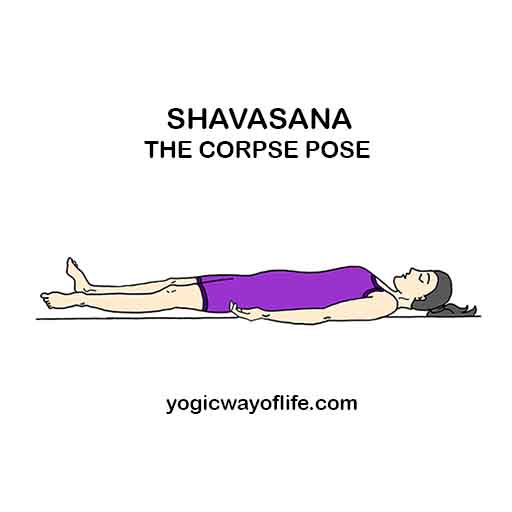
Lie down on the floor, stretching the legs out, allowing the feet to fall to the sides. Stretch out the arms, away from the body, leaving enough space for the armpits to breathe. Close the eyes and focus on the breath. Breathe in peace and calm. Breathe out stress and anxiety. Lie down in the posture, practicing mindful breathing, until complete relaxation sets in.
PRANAYAMA FOR YOGA MANAGEMENT OF DIABETES
Kapalabhati
Kapalabhati is a breathing practice, which is generally classified under Shatkarma or the cleansing techniques in Hatha Yoga. In this breathing technique, the inhalation is normal while exhalation I forced.
Sit in a comfortable position. Take a deep breath and exhale forcefully. In the beginning start with about 20 rounds. One can increase it to 120 rounds. During the practice, the belly goes inwards during exhalation, compressing and toning the organs in the abdomen. This process tones the pancreas which rests just below the stomach in the middle of the upper abdomen.
Once you are familiar with Kapalabhati pranayama, it can be done for prolonged duration (10 – 20 minutes) to get quicker results for yoga management of diabetes.
Anulom Vilom Pranayama
Tackling the stress and keeping it under control is essential to prevent diabetes from worsening. And, Alternate Nostril Breathing is one of the most advised stress management technique.
This is a deep breathing style where inhalations and exhalations are done alternatively through alternate nostrils.
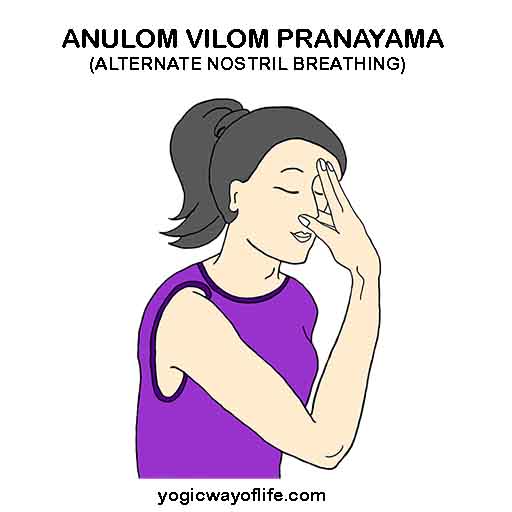
Sit in a comfortable seated posture. Straighten and lengthen the spine, close the eyes, and relax the body. Let the left palm rest on the left knee. Allow the tips of the thumb and index fingers of the left hand be in contact. Using the right thumb, close the right nostril. Use the right ring finger to close the left nostril. Rest the index and middle fingers of the right hand in between the eyebrows. Stretch the little finger to the ceiling.
Open the left nostril and take a slow inhalation for a count of four. Close the left nostril, open the right, and breathe out for a count of 4. Inhale through the right for a count of four, close the right, open the left, and exhale for a count of 4. This completes one round of Anulom Vilom Pranayama. Practice 20 rounds.
After mastering this practice, alter the ratio of inhalations and exhalations to 1:2. This will help to relax better. The longer the exhalations are, the more relaxing it will be.
CONCLUSION
Along with these postures, Pranayama, and Mudra, Uddiyana Bandha also helps to stimulate the functioning of pancreas. However, it is advisable to learn it under proper supervision to avoid complications.
Yoga alone cannot do wonders in managing diabetes. The key is to develop and practice a yoga management of diabetes schedule consisting of the four pillars:
- Diet
- Yoga / Exercise
- Sleep
- Anti-diabetic medications
Thus, Yoga management of diabetes is possible with yoga and healthy changes in your lifestyle.
